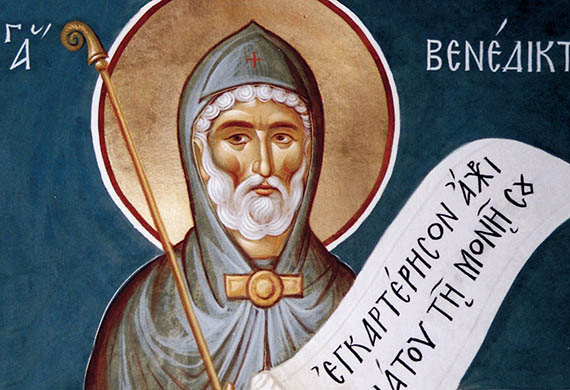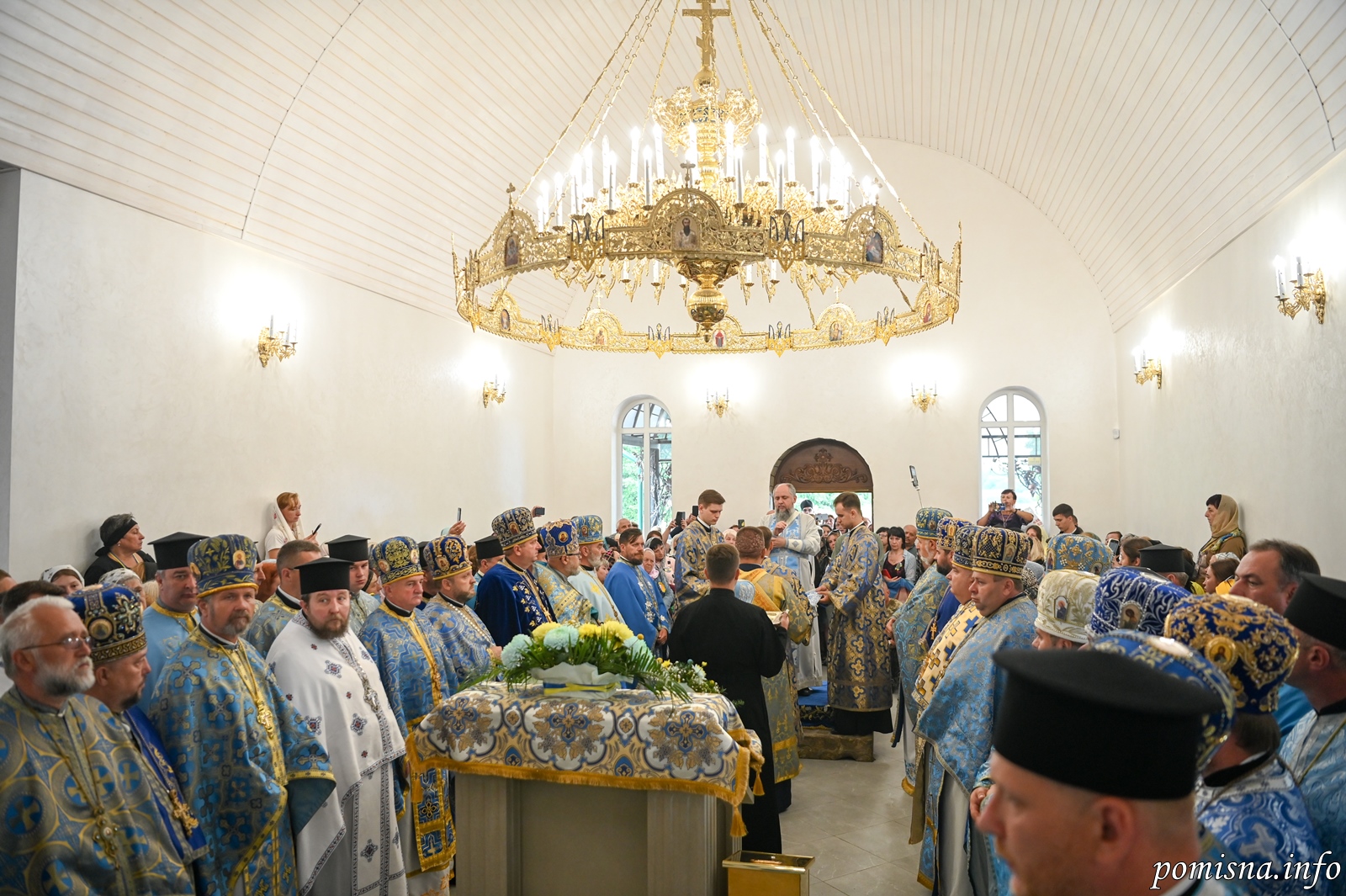Venerable Benedict of Nursia (14 March)


Saint Benedict, founder of Western monasticism, was born in the Italian city of Nursia in the year 480. When he was fourteen years of age, the saint’s parents sent him to Rome to study. Unsettled by the immorality around him, he decided to devote himself to a different sort of life.
At first Saint Benedict settled near the church of the holy Apostle Peter in the village of Effedum, but news of his ascetic life compelled him to go farther into the mountains. There he encountered the hermit Romanus, who tonsured him into monasticism and directed him to live in a remote cave at Subiaco. From time to time, the hermit would bring him food.
For three years the saint waged a harsh struggle with temptations and conquered them. People soon began to gather to him, thirsting to live under his guidance. The number of disciples grew so much, that the saint divided them into twelve communities. Each community was comprised of twelve monks and was a separate skete. The saint gave each skete an igumen from among his experienced disciples, and only the novice monks remained with Saint Benedict for instruction.
The strict monastic Rule Saint Benedict established for the monks was not accepted by everyone, and more than once he was criticized and abused by dissenters.
Finally he settled in Campagna and on Mount Cassino he founded the Monte Cassino monastery, which for a long time was a center of theological education for the Western Church. The monastery possessed a remarkable library. Saint Benedict wrote his Rule, based on the experience of life of the Eastern desert-dwellers and the precepts of Saint John Cassian the Roman (February 29).


The Rule of Saint Benedict dominated Western monasticism for centuries (by the year 1595 it had appeared in more than 100 editions). The Rule prescribed the renunciation of personal possessions, as well as unconditional obedience, and constant work. It was considered the duty of older monks to teach the younger and to copy ancient manuscripts. This helped to preserve many memorable writings from the first centuries of Christianity.
Every new monk was required to live as a novice for a year, to learn the monastic Rule and to become acclimated to monastic life. Every deed required a blessing. The head of this cenobitic monastery is the igumen. He discerns, teaches, and explains. The igumen solicits the advice of the older, experienced brethren, but he makes the final decisions. Keeping the monastic Rule was strictly binding for everyone and was regarded as an important step on the way to perfection.
Saint Benedict was granted by the Lord the gift of foresight and wonderworking. He healed many by his prayers. The monk foretold the day of his death in 547. The main source for his Life is the second Dialogue of Saint Gregory.
Saint Benedict’s sister, Saint Scholastica (February 10), also became famous for her strict ascetic life and was numbered among the saints.
This Saint, whose name means “blessed,” was born in 480 in Nursia, a small town about seventy miles northeast of Rome. He struggled in asceticism from his youth in deserted regions, where his example drew many who desired to emulate him. Hence, he ascended Mount Cassino in Campania and built a monastery there. The Rule that he gave his monks, which was inspired by the writings of Saint John Cassian, Saint Basil the Great, and other Fathers, became a pattern for monasticism in the West; because of this, he is often called the first teacher of monks in the West. He reposed in 547.
Benedict was born in the Italian province of Nursia in the year 480 A.D., of wealthy and distinguished parents. He did not remain long in school for he realized himself that through book-learning he could lose “the great understanding of his soul.” He left school “an unlearned wise man and an understanding fool.” He retreated to a monastery, where he was tonsured by the monk Romanus, after which he withdrew to a steep mountain, where he remained in a cave for more than three years in a great struggle with his soul. Romanus brought him bread and lowered it down the steep mountain on a rope to the opening of the cave. When Benedict became known in the vicinity, he withdrew from this cave in order to retreat from the glory of men. He was merciless toward himself. Once, when an unclean and raging passion of the flesh seized him, he removed all his clothes and rolled around naked in the thorns until he repelled every thought of a woman. God endowed him with many spiritual gifts: clairvoyance, healing, the expelling of evil spirits, the raising of the dead, and the ability to appear to others from a distance in visions and dreams. Once, Benedict perceived that a glass of wine served to him was poisoned. When he made the sign of the Cross over it, the glass burst. In the beginning he established twelve monasteries, and in each of them he placed twelve monks. Later he compiled the special “Benedictine” rule, which is followed even today in the Roman Church. On the sixth day before his death, he ordered that his grave, which had been prepared earlier, be opened, for the saint foresaw that his end was near.
He assembled all the monks, counseled them, and then gave up his soul to the Lord, Whom he had faithfully served in poverty and in purity. Scholastica, his sister by birth, lived in a convent, where, in imitation of her brother, she great subdued herself and reached a high state of spiritual perfection. When St. Benedict gave up his soul, two monks, one traveling on the road and one at prayer in a faraway cell, simultaneously saw the same vision. They saw a path extending from earth to heaven, covered with a precious woven fiber and illuminated on both sides by rows of men. At the head of the path, there stood a man of indescribable beauty and light, who said to them that this path was prepared for Benedict, favored by God. As a result of this vision, these two brothers learned that their good abbot had departed from this world. He reposed peacefully in the year 543 A.D. and entered into the Eternal Kingdom of Christ the King.
Apolytikion of Benedict of Nursia
Plagal of the Fourth Tone
The image of God, was faithfully preserved in you, O Father. For you took up the Cross and followed Christ. By Your actions you taught us to look beyond the flesh for it passes, rather to be concerned about the soul which is immortal. Wherefore, O Holy Benedict, your soul rejoices with the angels.
Kontakion of Benedict of Nursia
Plagal of the Fourth Tone
O sun that shinest with the Mystic Dayspring’s radiance, who didst enlighten the monastics of the western lands, thou art worthily the namesake of benediction; do thou purge us of the filth of passions thoroughly by the sweat of thine illustrious accomplishments, for we cry to thee: Rejoice, O thrice-blessed Benedict.
Source: oca.org / goarch.org / westserbdio.org




